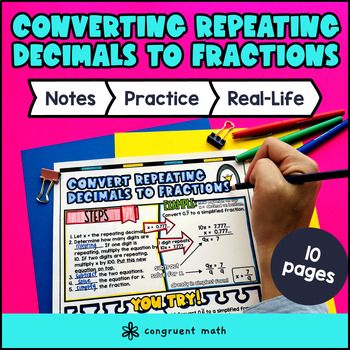Want more ideas and freebies?
Get my free resource library with digital & print activities—plus tips over email.
Join for Free Resources →
$4.25
Ever wondered how to teach converting repeating decimals to fractions in an engaging way to your eighth-grade students?
In this lesson plan, students will learn about converting from repeating decimals to fractions and their real-life applications. Through artistic, interactive guided notes, checks for understanding, a practice color by number activity, and a maze worksheet, students will gain a comprehensive understanding of converting repeating decimals to fractions.
The lesson culminates with a real-life example that explores how rational number conversions are used in practical situations. Students will read and write about the real-life applications of converting repeating decimals to fractions.

$4.25
After this lesson, students will be able to:
Before this lesson, students should be familiar with:
As a hook, ask students why converting repeating decimals to fractions is important in real-life situations. Refer to the last page of the guided notes for ideas.
Use the first page of the guided notes to introduce the concept of converting repeating decimals to fractions. Walk through the key points of the topic, including the notation used to represent repeating decimals, the process of converting repeating decimals to fractions, and how to set up and solve the equations. Refer to the guided notes for examples and practice.
Based on student responses, reteach concepts that students need extra help with. If your class has a wide range of proficiency levels, you can pull out students for reteaching, and have more advanced students begin work on the practice exercises.
Have students practice converting from repeating decimals (one or two repeating digits) to fractions using the practice worksheet on page 2 of the guided notes. Walk around to answer student questions.
Fast finishers can dive into the maze or color by number activity for extra practice. You can assign it as homework for the remainder of the class.
Bring the class back together, and introduce the concept of real-life applications for converting repeating decimals to fractions. Explain that understanding how to convert repeating decimals to fractions can be useful in various real-life situations that involve measurements, calculations, and comparisons.
Refer to the last page of the guided notes for more ideas on how to teach the real-life applications of converting repeating decimals to fractions.
If you’re looking for digital practice for converting between fractions, decimals, percents, try my Pixel Art activities in Google Sheets. Every answer is automatically checked, and correct answers unlock parts of a mystery picture. It’s incredibly fun and a powerful tool for differentiation.
Here is one activity to explore:
A repeating decimal is a decimal number that has a digit or a group of digits that repeat infinitely.
To convert a repeating decimal to a fraction, follow these steps:
Yes, repeating decimals can be converted to fractions because they are rational numbers.
A terminating decimal is a decimal number that ends after a finite number of digits, while a repeating decimal is a decimal number that has a digit or a group of digits that repeat infinitely.
To identify if a decimal is repeating or terminating, you can look for patterns in the digits after the decimal point. If there is a pattern that repeats indefinitely, it is a repeating decimal. If the digits do not form a pattern and the decimal ends, it is a terminating decimal.
Converting repeating decimals to fractions is important because it allows us to represent repeating decimals in a different form that is easier to work with in calculations and comparisons. Fractions provide a precise representation of numbers, which can be helpful in various mathematical and real-life applications.
Get my free resource library with digital & print activities—plus tips over email.
Join for Free Resources →